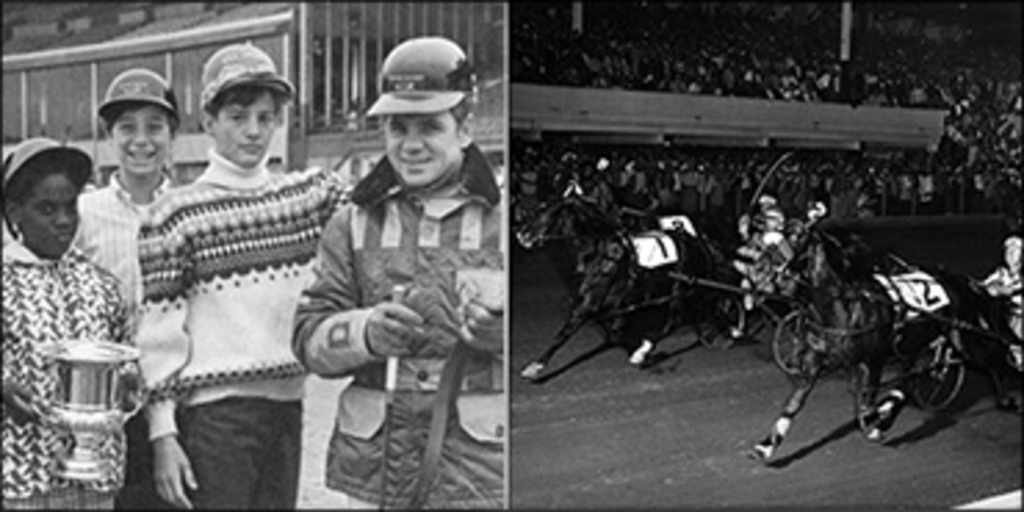
 In this week's Rewind Robert Smith recalls a special promotional day held at Yonkers Raceway back in 1969. The piece also delves into the introduction of driving helmets which began around 1960.
In this week's Rewind Robert Smith recalls a special promotional day held at Yonkers Raceway back in 1969. The piece also delves into the introduction of driving helmets which began around 1960.
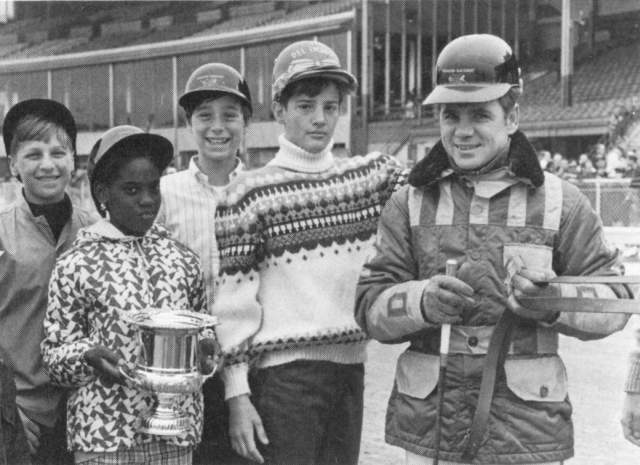
Driver Del Insko accompanied by a group of youngsters tries on one of the helmets given out on Free Helmet Day held at Yonkers Raceway. This 1969 photo was taken in the winner's circle after he drove Overcall to his 19th consecutive victory. One lucky young lad also got to hold the silver trophy presented to the winner. [Harness Horse]
Back on Saturday, October 25, 1969 a cheering throng of 15,000 kids and their parents gathered at Yonkers Raceway for the first ever Helmet Day in harness racing history. They also got to watch Overcall, one of the greatest horses of that era record his 19th straight victory. It was a big day for the youngsters and the first time many of them had attended a harness race.
The free-admission card, which was raced as a matinee affair, attracted a mammoth crowd that jammed the seating area and also crowded the rail five and six deep. Cars and buses filled the clubhouse and regular parking lots. Although the track announced that the gates would open at 9:00 a.m., crowds began to gather shortly after 7 o'clock that morning. Each child under the age of 16 was given a free helmet as they passed through the turnstiles.
A high-quality five race program was presented to the fans and everyone in attendance was aware that they were seeing a true champion in action as Overcall put on quite a show. Driven as always by Del Insko, one of the great horsemen of the modern era, the son of Capetown went on to an impressive 19th win in a row. Leaving from the outside post six the crack pacer soon grabbed the racetrack after a brief tussle with Rum Customer (Wm. Haughton) and reached the quarter in 29.4. Insko and Overcall retained the lead with Haughton nestled in the two hole. Midway through the stretch Rum Customer made a valiant bid to upset the heavy favourite but was still a length short at the wire with Hodgen Special taking the show spot. Time for the mile was 2:01.2 and the purse was $25,000.
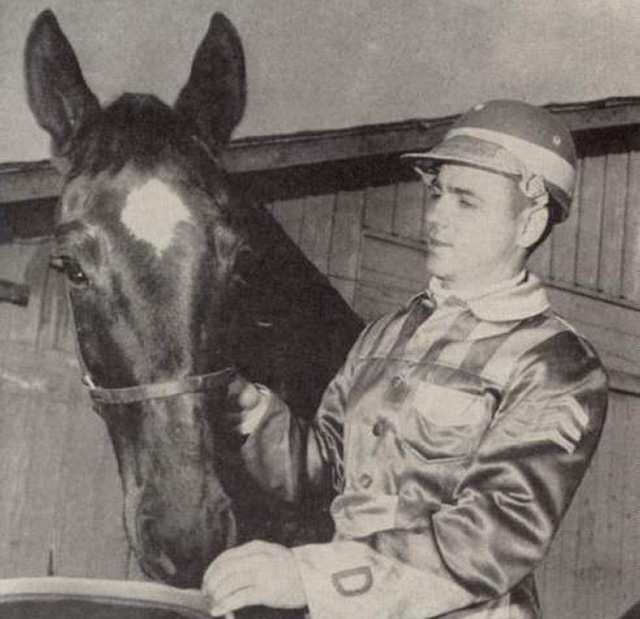
Del Insko shown wearing a very early driving helmet in 1960 [Hoof Beats]
The win by Overcall boosted his season's earnings to $303,150 and hiked his lifetime bankroll to $714,000. Despite the lateness of the season Insko and his great pacer were still headed to California for two more major tests in November. Four other non-betting events filled out the afternoon card. It turned out to be a great way to spend a late October day, and it was all for FREE!
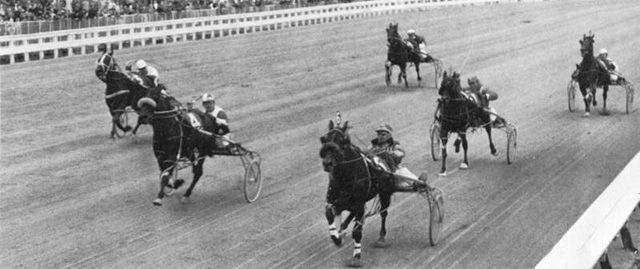
Overcall (6) and Del Insko reach the wire first in a six horse field at Yonkers, with Rum Customer (4) second. Although held as a non-betting matinee event it drew a very large crowd [Harness Horse]
When I first started attending the races, all drivers were still wearing the old style soft silk hats. They had been part of the standard driver's apparel dating back to who knows when. While they were stylish and perhaps even almost 'natty', they provided absolutely zero protection. The caps were usually made of the exact material as the silk jackets and bore the same matching colours. They used to occasionally fly off in the heat of battle or even on a windy day.
Around 1958, a movement began to introduce protective helmets into harness racing. Their obvious purpose was to provide a safeguard against head injuries in what was quite a dangerous occupation. Like most attempts to change long standing practices, the idea was met with general skepticism and negative reaction. How could anyone think of tampering with one of the oldest traditions in the sport? This was the public opinion of even the great horseman Frank Ervin who raced some of the sport's all time greats such as Bret Hanover of course after this time.
Quite some time before anyone in the regulatory body of harness racing was involved,one of the sport's leading and most famous drivers became proactive. Delvin Miller who seemed to be involved in virtually everything to do with harness racing had an idea; good ideas were part of his repertoire, it seems. Delvin hailed from Pennsylvania and he was somehow connected to just about everyone in his beloved State. His home was located near Pittsburgh and he was just naturally a Pirates fan. He paid a visit to their training facility and asked for a quantity of batting helmets which were also just making their way into the world of baseball.
He took the helmets to Roosevelt Raceway and deposited them in the paddock. Just by word of mouth he asked that some of his fellow drivers give them a try during training miles and report back informally to him. Apparently sufficient drivers tried them and liked them and in a relatively short time when helmets were made mandatory the transition went rather smoothly. There were often times that drivers wearing helmets competed against those who still chose to don the old fashioned soft hats as shown in an accompanying picture.
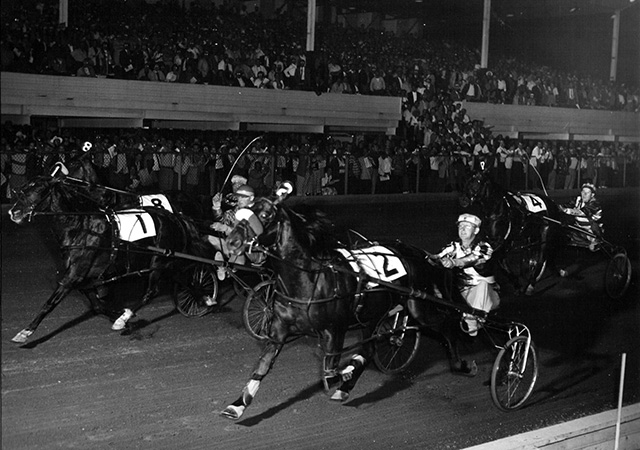
A close inspection of this 1958 photo shows Harold Wellwood, the driver of the winning horse Pretty Polly (1) is wearing a helmet. The driver of the second place finisher Carl Fockler (2) has the old soft cap. A large Northville Downs crowd looks on.
The phasing in of driving helmets was a rather protracted process and in fact it was several years before it came into full effect. Some racing jurisdictions encouraged the wearing of helmets but did not immediately make them a requirement. Others allowed the old style soft caps for a while longer. Eventually the new and sometimes controversial head protection was universally required and no driver was allowed to compete without approved headgear.
While the original plan was well-intentioned, it still left a lot to be desired as to how people complied with the rules. The first official rule required drivers to wear "a type of protective helmet constructed with a hard shell and contain adequate padding and a chin strap in place." This rather vague instruction left people wearing everything from construction helmets to a variety of other thin and non protective forms of headgear that afforded the wearer little or no protection. I can recall seeing some pretty interesting and certainly oddball headpieces back in the day.
Down through the past over 50 years many discussions, controversies and resulting technological changes have taken place, often after a tragic accident or even a death. Helmets have come a long way and undoubtedly they will continue to change and evolve into the future.
The sight of an old soft silk hat will forever warm my heart.
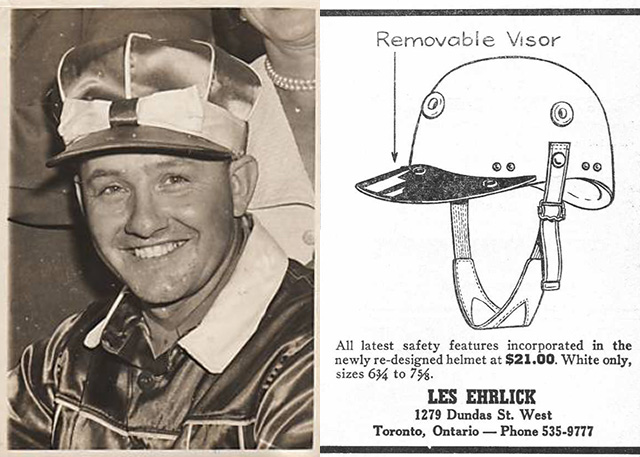
Left: Delvin Miller, the great U.S. horseman wearing an old style silk cap. Right: Back in 1967, which was Canada's Centennial Year, the pictured helmet was offered for sale by well known Tack supplier Les Ehrlick. It sold for the princely sum of $21.00 and came in any colour you wanted as long as it was white!
Happy Easter to everyone in the Rewind audience.


Jack McNiven passed along an
Jack McNiven passed along an interesting comment to do with the transition from silk hats to protective helmets. He recounted that the noted Pennsylvania horseman Harry Harvey was not too pleased to see the soft hat era pass completely. To ease the "pain" he had a covering specially made to fit over his helmet crafted from the same material as his maroon colours.
Jack also spoke of his brother Don having a custom made silk hat fashioned by the Riegle Silks folks in a colour consistent with the Killean Farm green. It was used as part of the McNiven Farm's display at all sales, an obvious gesture toward a past tradition of our sport.